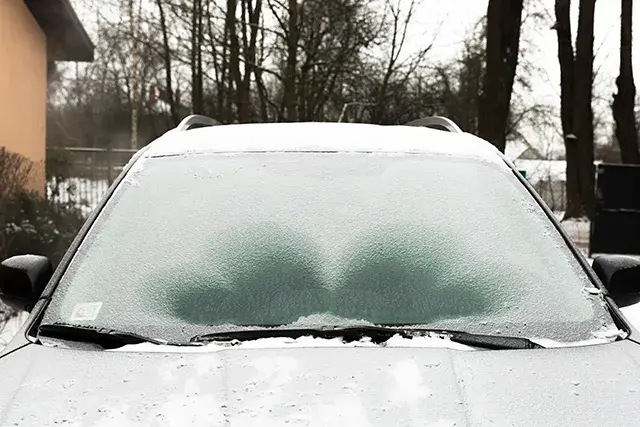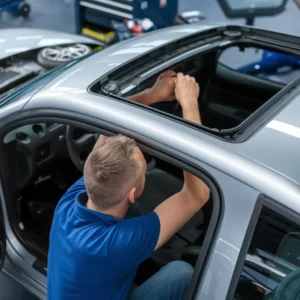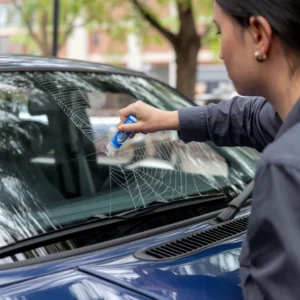Windshield Chip Repair | Quick Fixes for a Safer Drive Windshield chip repair is crucial...
Unlocking the Mystery| How Hot Water on Windshield Clears Frost
Hot water on windshield refers to the practice of pouring warm or hot water onto a vehicle’s windshield to remove ice or frost during cold weather conditions. This method is often employed when traditional scraping techniques prove to be challenging or time-consuming, especially in freezing temperatures. While it may seem like a quick fix, using hot water on a windshield can pose risks and potential damage to the glass.
Pouring Hot Water on Windshield

Procedure for Pouring Hot Water on Windshield:
Prepare hot water: Boil water in a kettle or pot until it reaches a suitable temperature. Do not use water that is boiling vigorously as it may crack the windshield.
Pour water carefully: Slowly pour the hot water onto the windshield in a steady stream, starting from the top and working your way down. Avoid pouring too much water at once to prevent sudden temperature changes.
Use a scraper: While the hot water helps to melt the ice, use a windshield scraper to gently remove any remaining ice or frost from the windshield.
Wipe dry: After removing the ice, use a clean cloth or paper towel to wipe the windshield dry to prevent refreezing.
Safety Precautions to Consider:
Wear gloves: Hot water can cause burns, so it’s essential to wear protective gloves when handling hot water.
Stand clear: Be cautious when pouring hot water to avoid splashing onto yourself or others nearby.
Use tempered glass: Ensure your vehicle’s windshield is made of tempered glass, which is more resistant to sudden temperature changes. Avoid pouring hot water on laminated glass windshields, as they may crack.
Avoid extreme temperatures: Do not pour hot water on a windshield that is already cracked or chipped, as this can exacerbate the damage.
Effectiveness in Removing Ice and Frost:
Pouring hot water on a windshield can effectively melt ice and frost, making it easier to remove with a scraper. However, the effectiveness may vary depending on the thickness of the ice and the temperature outside.
Potential Risks and Drawbacks:
Thermal shock: Rapid temperature changes from pouring hot water on a cold windshield can cause thermal shock, leading to cracks or shattering of the glass.
Damage to paint and trim: Hot water dripping onto the vehicle’s paint or trim can cause damage over time, such as discoloration or peeling.
Inefficient in extreme cold: In extremely cold temperatures, the hot water may freeze before effectively melting the ice, rendering this method ineffective.
Safety concerns: Handling hot water poses a risk of burns, and pouring it onto a windshield can create slippery conditions, increasing the risk of accidents.
Is it OK to Use Hot Water on Windshield?
Discussion on the Safety Aspect:
Using hot water on a windshield can pose safety risks depending on various factors. One primary concern is thermal shock, which can occur when hot water comes into contact with a cold windshield, causing it to crack or shatter due to sudden temperature changes. Additionally, if the water is boiling or near boiling, there’s a risk of burns if it splashes back on you during application. Moreover, pouring hot water on an icy windshield in extremely cold conditions can lead to the water freezing rapidly, creating a thicker layer of ice and exacerbating the problem.
Analysis of Potential Damage to Windshield:
The main risk of using hot water on a windshield is thermal stress. Glass expands when heated and contracts when cooled. Pouring hot water on a cold windshield can cause uneven expansion and contraction, leading to cracks or even breakage. Even if the windshield doesn’t break immediately, the stress caused by thermal shock can weaken it over time, making it more susceptible to damage from minor impacts or changes in temperature. Additionally, hot water may not effectively remove ice or frost from the windshield, potentially requiring additional scraping or wiping, which could scratch the glass surface. If you want professional guidance the Reliable Auto Glass is best in business.
Comparison with Alternative Methods:
Using hot water on a windshield is generally not recommended due to the safety and potential damage concerns outlined above. Alternative methods such as using a scraper, de-icing spray, or applying a windshield cover or tarp overnight are safer and more effective options for removing ice and frost. Scraping with a proper ice scraper or using a de-icing spray specifically designed for automotive use eliminates the risk of thermal shock and minimizes the potential for damage to the windshield.
Advantages And Disadvantages Of Using Hot Water On Windshield
Advantages of Using Hot Water on Windshield:
Quick Removal of Ice and Frost:
Using hot water on the windshield helps to rapidly melt and remove ice and frost, saving time and effort compared to scraping or waiting for the defroster to work.
Cost-Effectiveness:
Hot water is often readily available and inexpensive, making it a cost-effective solution for clearing ice and frost from the windshield, especially compared to specialized de-icing products.
Accessibility:
Hot water can be easily accessed from household sources such as a kettle or tap, making it convenient for use in emergency situations or when other de-icing methods are unavailable.
Disadvantages of Using Hot Water on Windshield:
Risk of Cracking or Damaging the Glass:
Pouring hot water onto a cold windshield can create a sudden temperature differential that may cause the glass to crack or shatter, especially if it has existing chips or imperfections.
Potential Harm to Surrounding Components:
Hot water runoff can potentially damage surrounding components such as windshield wipers, seals, or the vehicle’s paint if not carefully directed away from these areas.
Environmental Concerns:
Using hot water for de-icing can contribute to water wastage, especially if large quantities are used. Additionally, the runoff containing dissolved ice and debris may flow into storm drains, potentially contaminating the environment.
Conclusion
In conclusion, the use of hot water on a windshield is a practice that can have both benefits and risks. Throughout this discussion, several key points have been highlighted. Firstly, hot water can effectively melt ice and snow, making it easier to remove from the windshield, thus improving visibility and safety while driving in winter conditions. However, it’s important to note that pouring hot water on a cold windshield can also pose risks, such as thermal shock leading to cracks or even shattering of the glass due to sudden temperature changes. Feel free to contact us for any type of services or query like hot water on windshield.
FAQs
Is It Safe To Pour Hot Water On My Windshield To Remove Ice?
Pouring hot water on a cold windshield can cause thermal shock, leading to cracks or even shattering. It’s not recommended to use hot water to de-ice your windshield.
What Temperature Water Should I Use To Remove Ice From My Windshield?
It’s best to use lukewarm or tepid water, slightly above room temperature. Extremely cold water may not effectively melt the ice, while hot water can damage the windshield.
Can Pouring Hot Water On A Frosted Windshield Save Time Compared To Scraping?
While it may seem like a quicker solution, the potential damage to your windshield outweighs any time saved. Using a proper ice scraper or de-icing solution is safer and more effective.
Will Pouring Hot Water On My Windshield Damage The Defroster Or Windshield Wiper System?
Yes, hot water can potentially damage the delicate components of your defroster or windshield wiper system, leading to costly repairs. It’s best to avoid using hot water altogether.
What Are Safer Alternatives To Hot Water For De-Icing Windshields?
There are several alternatives, including using a commercial de-icer spray, rubbing alcohol mixed with water, or a solution of vinegar and water. Additionally, investing in windshield covers or parking in a garage can prevent frost buildup.
Our Services
Our Latest Blogs
1986 Porsche 944 Sunroof Replacement | Expert Installation
1986 Porsche 944 Sunroof Replacement | Expert Installation 1986 Porsche 944 sunroof replacement is an...
Sunroof Seal Replacement | Say Goodbye to Water Leaks
Sunroof Seal Replacement | Say Goodbye to Water Leaks Sunroof seal replacement is essential for...
How to Stop My Windshield Crack from Spreading
How to Stop My Windshield Crack from Spreading How to stop my windshield crack from...





